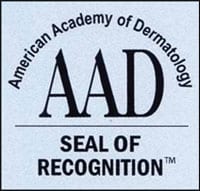 |
The American Academy of Dermatology (AAD) Seal of Recognition™ Program has come under fire from a group of disgruntled physicians. Under the program, companies are charged for the privilege of displaying the academy’s logo on sun-protection products. The companies must pay a $5,000 application fee; $10,000 upon acceptance into the program; and $10,000 on the 1-year anniversary of acceptance.
The program is a conflict of interest, according to A. Bernard Ackerman, MD, FAAD, dermatologist and director emeritus of the Ackerman Academy of Dermatopathology in New York City.
“The Seal of Recognition Program is unethical because there are conflicts of interest within a conflict of interest,” Ackerman says. “The latter is an Academy of Dermatology selling its seal of recognition to manufacturers of sunscreens for a substantial fee at the same time that it promotes vigorously the use of sunscreen.”
On February 4, Ackerman initiated a petition to have a special meeting regarding the Seal of Recognition Program during the recent AAD meeting in San Antonio. The 81 signatures, (66 of which were valid signatures of Academy members who are eligible to vote, representing 0.5% of the 12,060 eligible voting members), fulfilled the requirement for a meeting, according to the AAD’s bylaws.
The Advisory Board, which advises the AAD’s board of directors, voted that day before the special meeting to recommend that the board of directors rescind the Seal of Recognition Program.
Fewer than 100 voting members of the Academy attended the special meeting, so a quorum could not be established at any time during the meeting and no formal actions could be taken. At the conclusion of the meeting and in the absence of quorum, a member asked to conduct a closed ballot straw poll. The results of the straw poll yielded 60% in favor of the program either with or without fees, according to the AAD.
Specifically, 31 supported the program, 18 supported the program with no fees, and 31 opposed the program.
During the special meeting, individual members spoke for and against the program. One of the questions raised included comparison of the AAD Seal of Recognition Program to the AMA-Sunbeam agreement, which represented a seal of approval, which was an exclusive endorsement in which royalties from Sunbeam products were to be paid to the AMA. Another question was the relevance of current officer disclosures about actual or potential conflicts of interest. During the meeting, officers, committee volunteers, and speakers disclosed their relationships with the industry.
According to the AAD, the Seal of Recognition Program was conceived to be implemented in skin care products that include sunscreen protection, as well as products manufactured strictly for use as sunscreen, including clothing, hats, sunglasses, laundry additives, shade structures, and umbrellas. All the products must be tested according to a specific criteria, and must show independent lab results of a sun protection factor of 15 or higher and broad-spectrum UVA and UVB protection.
Companies that apply for the program must submit accurate formulation and scientific testing data for their products. Companies that apply also pay a fee to cover the costs of administering the program, which funds skin cancer public education programs, says the AAD.
According to the Indoor Tanning Association, this issue is further evidence of the incestuous and unethical relationships between the dermatological community and the skin care industry.
“The skin care industry is running away from the Seal of Recognition Program of the American Academy of Dermatology,” Ackerman says. “It does not want to be tarnished by the obvious conflict of interest, especially in the context of that conflict having been brought forcefully to attention in the public arena. Only a single manufacturer of sunscreen—namely, Johnson & Johnson—has received the Seal of Recognition. There is clearly no rush on the part of the skin care industry to receive the Seal of Recognition.”
 |
| See also “Skin Cancer—The Burning Truth: Plastic Surgery at Bargain Prices?” by Rima Bedevian in PSP, June 2007. |
Ackerman says that prior to establishing the Seal of Recognition Program, the AAD hired a company to poll 3% of the membership concerning opinions of a seal program. According to the AAD, 86% of those polled were in favor of such a program. What the AAD did not disclose, however, was that not a single question went to the core of the matter—namely, the conflict of interest on the part of the AAD itself and its leaders.
According to Ackerman, at its next meeting, which is scheduled to take place in the next 3 months, the board of directors will make its decision with regard to rescinding the program.
“It is in near certainty that it will reject the recommendation because the AAD not only is going forward with the program, it is expanding it from sunscreens only to include protective clothing, hats, and laundry additives. Once a decision has been rendered by the board of directors, the petitioners will rethink the matter and act accordingly,” Ackerman says.
The Academy will communicate the information discussed at the special meeting (including the straw poll results) to the general membership via its Web site, Dermatology World, and other communication vehicles.




